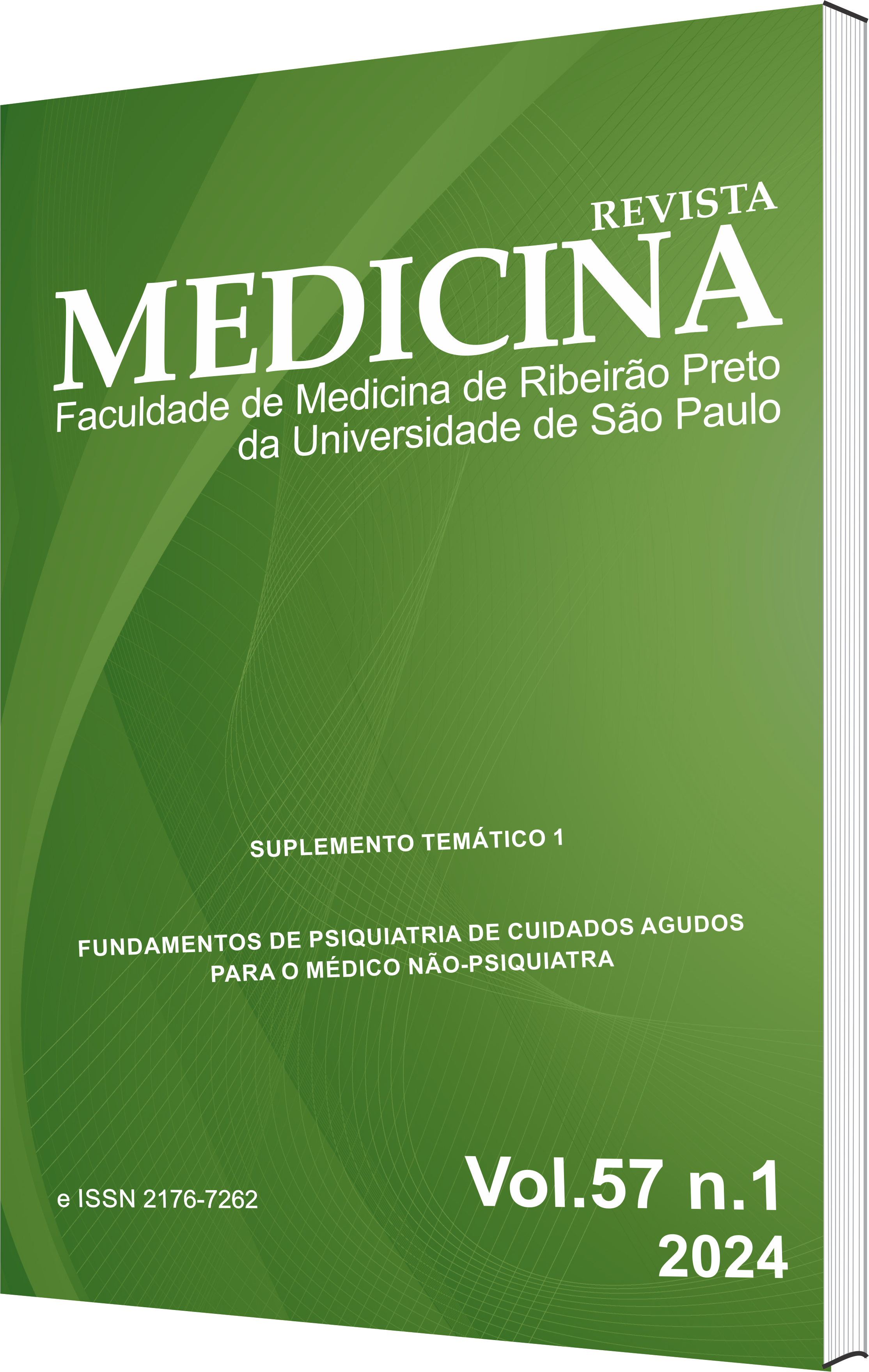The challenge of psychomotor agitation on clinical practice
DOI:
https://doi.org/10.11606/issn.2176-7262.rmrp.2024.221903Keywords:
Psychomotor agitation, Violent patient, Behavioral de-escalation, Rapid tranquilization, Treatment, Pharmacological interventionAbstract
In this article we will discuss the clinical approach for the management of psychomotor agitation, a common occurrence in emergency health care settings. The management of psychomotor agitation might be challenging for the health care provider, especially due to the associated risks for the patient and health care team. Thus, the utilization of a stepwise protocol is paramount for the success of this approach. The intervention should start by taking into account three fundamental steps in the management of agitation, such as: environmental, behavioral, and pharmacological. These steps could be summarized as: addressing or mitigating any underlying medical condition, warranting the safety of patient and health care personnel (environmental), behavioral management through de-escalation techniques, and as a last resource, the utilization of pharmacological interventions. The confidence of the health care provider in applying these principles is essential in the prevention of somber consequences of psychomotor agitation, such as severe injury and emotional trauma risk for patients and health care staff, and in the appropriate treatment of the general medical condition and/or psychiatric condition that could be the culprit of the agitation.
Downloads
References
Chevrolet JC, Jolliet P. Clinical review: Agitation and delirium in the critically ill – significance and management. Crit Care. 2007;11(3):214.
Nordstrom K, Zun LS, Wilson MP, Stiebel V, Ng AT, Bregman B, et al. Medical evaluation and triage of the agitated patient: consensus statement of the american association for emergency psychiatry project Beta medical evaluation workgroup. West J Emerg Med. 2012 Feb;13(1):3–10.
Zeller SL, Rhoades RW. Systematic reviews of assessment measures and pharmacologic treatments for agitation. Clin Ther. 2010;32:403–25.
Mantovani C, Migon MN, Alheira FV, Del-Ben CM. Manejo de paciente agitado ou agressivo. Revista Brasileira de Psiquiatria. 2010 Oct;32(suppl 2):S96–103.
Weltens I, Bak M, Verhagen S, Vandenberk E, Domen P, van Amelsvoort T, et al. Aggression on the psychiatric ward: Prevalence and risk factors. A systematic review of the literature. PLoS One. 2021 Oct 8;16(10):e0258346.
Huf G, Alexander J, Gandhi P, Allen MH. Haloperidol plus promethazine for psychosis-induced aggression. Cochrane Database of Systematic Reviews. 2016 Nov 25;2016(11).
George C, Jacob TR, Kumar A V. Pattern and correlates of agitation in an acute psychiatry in-patient setting in a teaching hospital. Asian J Psychiatr. 2016 Feb;19:68–72.
Lawrence RE, Rolin SA, Looney D V, Birt AR, Stevenson EM, Dragatsi D, et al. Physical Assault in the Psychiatry Emergency Room. J Am Acad Psychiatry Law. 2020 Dec;48(4):484–95.
Wong AH, Ray JM, Eixenberger C, Crispino LJ, Parker JB, Rosenberg A, et al. Qualitative study of patient experiences and care observations during agitation events in the emergency department: implications for systems-based practice. BMJ Open. 2022 May;12(5):e059876.
Rossi J, Swan MC, Isaacs ED. The violent or agitated patient. Emerg Med Clin North Am. 2010 Feb;28(1):235–56, x.
Meehan KM, Wang H, David SR, Nisivoccia JR, Jones B, Beasley CM, et al. Comparison of rapidly acting intramuscular olanzapine, lorazepam, and placebo: a double-blind, randomized study in acutely agitated patients with dementia. Neuropsychopharmacology. 2002 Apr;26(4):494–504.
Mantovani C, Labate CM, Sponholz A, de Azevedo Marques JM, Guapo VG, de Simone Brito dos Santos ME, et al. Are Low Doses of Antipsychotics Effective in the Management of Psychomotor Agitation? A Randomized, Rated-Blind Trial of 4 Intramuscular Interventions. J Clin Psychopharmacol. 2013 Jun;33(3):306–12.
Holloman G, Zeller S. Overview of Project BETA: Best Practices in Evaluation and Treatment of Agitation. Western Journal of Emergency Medicine. 2012 Feb 1;13(1):1–2.
Hoffmann JA, Pergjika A, Konicek CE, Reynolds SL. Pharmacologic Management of Acute Agitation in Youth in the Emergency Department. Pediatr Emerg Care. 2021 Aug 1;37(8):417–22.
Baldaçara L, Ismael F, Leite V, Pereira LA, dos Santos RM, Gomes Júnior V de P, et al. Brazilian guidelines for the management of psychomotor agitation. Part 1. Non-pharmacological approach. Brazilian Journal of Psychiatry. 2019 Apr;41(2):153–67.
Vieta E, Garriga M, Cardete L, Bernardo M, Lombraña M, Blanch J, et al. Protocol for the management of psychiatric patients with psychomotor agitation. BMC Psychiatry. 2017 Dec 8;17(1):328.
Mantovani C, Del Ben CM. Estudo comparativo de intervenções farmacológicas para o manejo de agitação psicomotora aguda. Universidade de São Paulo; 2015.
Spencer S, Johnson P, Smith IC. De-escalation techniques for managing non-psychosis induced aggression in adults. Cochrane Database of Systematic Reviews. 2018 Jul 18;2018(7).
Richmond J, Berlin J, Fishkind A, Holloman G, Zeller S, Wilson M, et al. Verbal De-escalation of the Agitated Patient: Consensus Statement of the American Association for Emergency Psychiatry Project BETA De-escalation Workgroup. Western Journal of Emergency Medicine. 2012 Feb 1;13(1):17–25.
Nordstrom K, Allen MH. Managing the Acutely Agitated and Psychotic Patient. CNS Spectr. 2007 Nov 7;12(S17):5–11.
Baldaçara L, Rocha GA, Leite V da S, Porto DM, Grudtner RR, Diaz AP, et al. Brazilian Psychiatric Association guidelines for the management of suicidal behavior. Part 1. Risk factors, protective factors, and assessment. Brazilian Journal of Psychiatry. 2021 Oct;43(5):525–37.
Baldaçara L, Diaz AP, Leite V, Pereira LA, dos Santos RM, Gomes Júnior V de P, et al. Brazilian guidelines for the management of psychomotor agitation. Part 2. Pharmacological approach. Brazilian Journal of Psychiatry. 2019 Aug;41(4):324–35.
Yatham LN, Kennedy SH, Parikh S V, Schaffer A, Bond DJ, Frey BN, et al. Canadian Network for Mood and Anxiety Treatments (CANMAT) and International Society for Bipolar Disorders (ISBD) 2018 guidelines for the management of patients with bipolar disorder. Bipolar Disord. 2018 Mar;20(2):97–170.
Hirsch S, Steinert T. The Use of Rapid Tranquilization in Aggressive Behavior. Dtsch Arztebl Int. 2019 Jun 28;116(26):445–52.
Gerson R, Malas N, Feuer V, Silver G, Prasad R, Mroczkowski M, et al. Best Practices for Evaluation and Treatment of Agitated Children and Adolescents (BETA) in the Emergency Department: Consensus Statement of the American Association for Emergency Psychiatry. Western Journal of Emergency Medicine. 2019 Feb 28;20(2):409–18.
Downloads
Published
Issue
Section
License
Copyright (c) 2024 Célia Mantovani

This work is licensed under a Creative Commons Attribution 4.0 International License.







